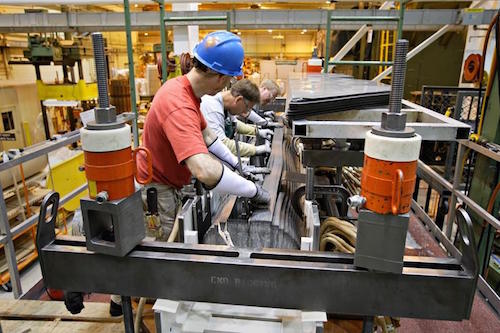A ruling by the National Labor Relations Board has reset the standard for how temporary employees can organize.

|
| The NLRB decision, Miller & Anderson, makes it easier for temporary employees to bargain with their permanent co-workers.
|
Returning to a rule set in 2000 known as Sturgis, the NLRB has made it easier for temporary employees to collectively bargain with their permanent counterparts. The case, Miller & Anderson, overturns a Bush-era decision, referred to as Oakwood, that requires employer consent for temporary workers to be in the same bargaining unit with permanent employees.
“People working side by side, doing the same job, shouldn’t have to get their boss’ permission to collectively bargain,” said International President Lonnie R. Stephenson. “That puts working people at an unnecessary disadvantage and the NLRB recognized that.”
In the decision, the NLRB stated, “requiring employer consent to an otherwise appropriate bargaining unit desired by employees, Oakwood has … allowed employers to shape their ideal bargaining unit, which is precisely the opposite of what Congress intended.”
“This is what our members live with every day, working alongside temporary employees, doing the same job. The community of interest is definitely there,” said Carmella Thomas, director of professional and industrial organizing. “And companies aren’t just hiring five or six temps. They’re hiring 30 or 40 a week at times.”
The ruling rests on the “community of interest” test, which looks at differences in factors like wages, hours, supervision, job function and qualifications. When enough of these are similar – or perhaps dissimilar in the case of wages – “solely employed” and “jointly employed” employees as the NLRB refers to them, would be deemed an appropriate unit for bargaining.
For temps doing the same job as permanent employees, but whose paychecks come from a staffing agency instead of the company, Miller & Anderson represents an opportunity to join forces and bargain for the benefits of full employment like health care and a pension, not to mention a higher wage. In short, if you’re doing the same work as the person next to you, you should have the same rights.
“We want to represent all employees whether they’re temporary or permanent,” Thomas said. “This ruling gives us the ability to do that.”
The decision could also create a disincentive for companies looking to avoid accountability and save money by hiring temporary staff, a situation in which they only pay a fee to the agency and don’t have to worry about protections like health care and workers’ compensation.
Thomas noted that the ruling is a win for permanent employees as well, since it levels the playing field and allows all employees to bargain for the same working conditions, meaning that temporary workers would no longer be a cheap alternative to permanent employees with benefits.
“When you see a bunch of permanent employees being let go, for no reason, and then management brings a bunch of temps in, it hurts morale,” Thomas said. “Job security goes out the window and you realize you can be replaced at any time. You’re not a value to them anymore.”
Miller & Anderson follows another NLRB case, Browning-Ferris Industries, in which the board determined that if a parent company contracts work and exercises substantial control over the conditions of employment, that company would now be considered a “joint employer” and therefore subject to the standards and laws that come with it.
In Browning-Ferris, the board also noted that its previous standard has not kept pace with the current labor market. As of 2014, the board stated, almost 3 million people were employed through temporary agencies.
A recent study from the University of California Berkeley looked at the use of public assistance programs, like Medicaid and food stamps, by manufacturing employees. The researchers found that about one-third of employees used at least one program. For temporary employees in manufacturing, it was half – similar to that of fast food employees.
“When you look at a lineman next to you making $10 less an hour, realize why they’re there. It’s because the company is trying to go cheaper,” Thomas said. “This gives our membership the opportunity to see temporary co-workers not as a threat, but as potential sisters and brothers, as people who should have the same negotiated contract as everyone else.”